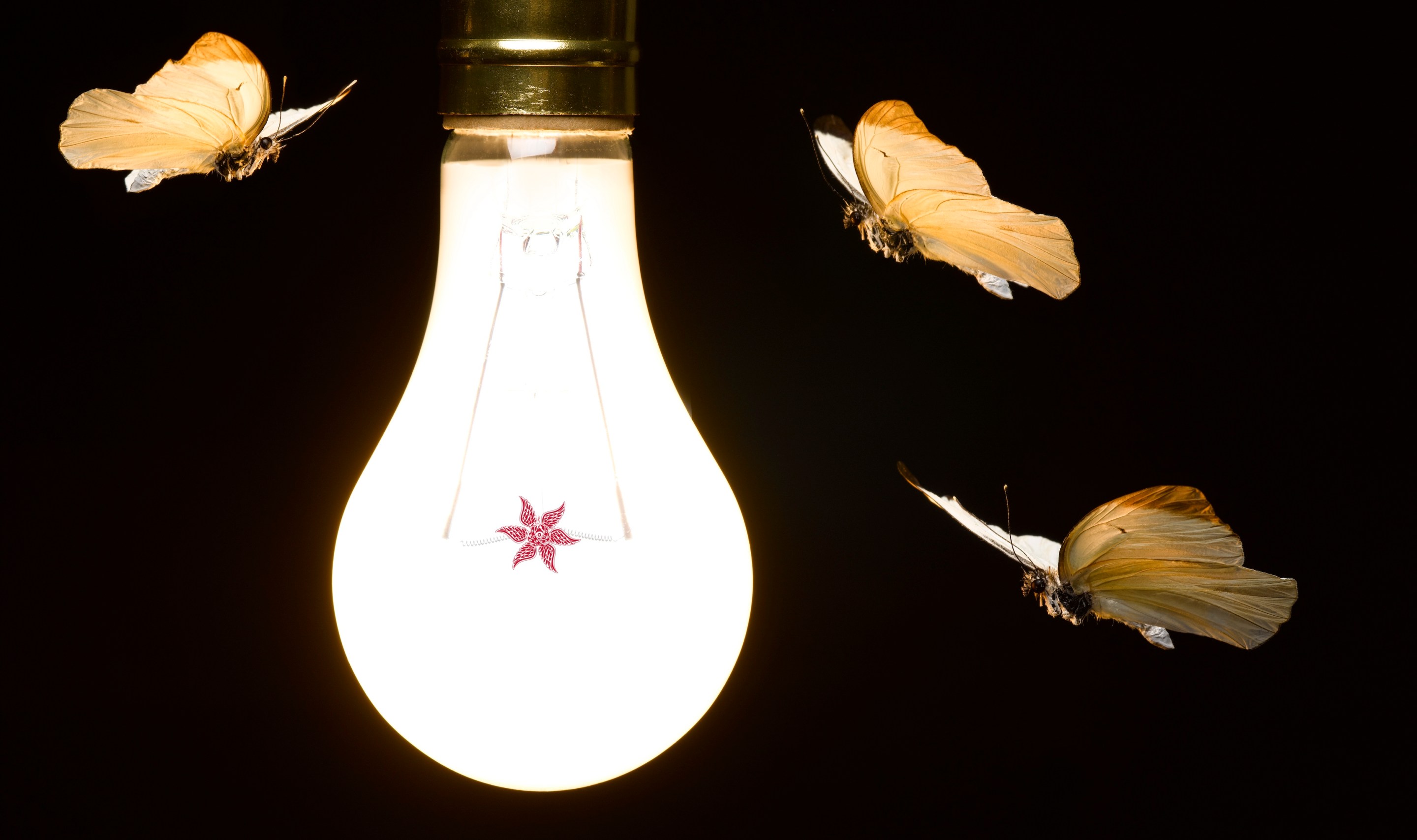Every moth meme originates from the same premise—the face of a nondescript brown moth, eyes shining in the dark, accompanied by text suggesting the moth's burning desire: "Hey buddy you have any LAMPS?!" It might seem reductive to distill a moth to cliché: a creature who has become go-to example of longing so irresistible that it becomes dangerous.
But the moths cannot help it, and their obsession is convenient for anyone who wishes to see the mostly nocturnal insects up close. For a few months now, when people ask me about my plans for the summer, I tell them "mothing," and when they look confused, I elaborate: "like birding, but for moths." This comparison is not entirely accurate. Birding might involve an idyllic walk in a park or along a seacoast, binoculars in hand to spot any birds perched on a branch or soaring overhead. Such tactics are fruitless on mothwatch, which must happen in the black of night. You cannot grope blindly in a dark forest in search of moths; you will only end up bug-bitten and disappointed. Instead, mothing operates on a simple premise: Turn on a light, and let the moths come to you.
When my friends then asked what I'd seen while mothing, I had to tell them the truth: I hadn't gone mothing yet because I was still tracking down all the equipment. "What equipment do you really need?" one friend asked. "A lamp?" They, and the memes, had a point. But I knew real moth-ers—also referred to as mothers by people who are down with homographs—swore by more expensive gear: collection-grade insect traps, portable generators, and mercury vapor lights, which are illuminated by high-pressure tubes of vaporized mercury. And I suspected these real mothers were not mothing in Brooklyn backyards drenched in light pollution.
I wanted the real deal. So I boarded an Amtrak, my tote bag stuffed with a change of clothes, a headlamp, and the book Discovering Moths: Nighttime Jewels in Your Own Backyard by John Himmelman. I was headed north to a farm in the Hudson Valley that kindly offered to let me borrow their equipment and moth on their land. The sun dipped in the sky as our train rattled forward, and I could see the other passengers getting sleepy, presumably headed home to end their day. But my night was just beginning, and so was the moths'.
In Lepidoptera, the order of insects that include moths and butterflies, butterflies have always hogged the spotlight—figuratively speaking. Our interest is not proportionate to the number of species of each group. While there are about 20,000 species of butterflies, there are about 160,000 species of moth. People love butterflies because they imagine them as beautiful—bright, iridescent wings fluttering in the light of the sun and folded together at rest. To many, the idea of a moth conjures images of tattered clothes, infested pantries, and drab brown wings. This bias is present even in their taxonomy: Butterflies are distinguished as a special suborder, and moths are the leftovers—all the other Lepidoptera that are not butterflies.
There are some general guidelines to distinguish between moths and butterflies, but these guidelines are riddled with exceptions. Butterflies often have thin, clubbed antennae, whereas moths usually have feathery or tapering antennae. Resting butterflies normally fold their wings up above their back like hands pressed together in prayer, and resting moths lay their wings folded flat or open. Butterflies are generally active at day, and moths at night. One actually strict difference between the two groups is a structure called a frenulum, which links a moth's wings together. The frenulum is not present in butterflies, whose forewings and hindwings flap separately. But when you are out in a field looking at a small, winged, fluttering thing, you will probably not be looking for a frenulum.
Although I have never felt a particular kinship to butterflies, I was drawn to mothing the instant I learned about it. To me, moths seemed to be the pandas of insects—big, cute, fluffy, bumbling, and generally harmless—and I wondered if they could be a gateway into appreciating insects that were much more difficult to love. Besides, I had recently seen a miracle of a moth—a velvety celery-green luna, certainly a conventionally attractive moth—fluttering outside the window of a barn, and wondered, for the first time, if I had fallen in love with a bug.
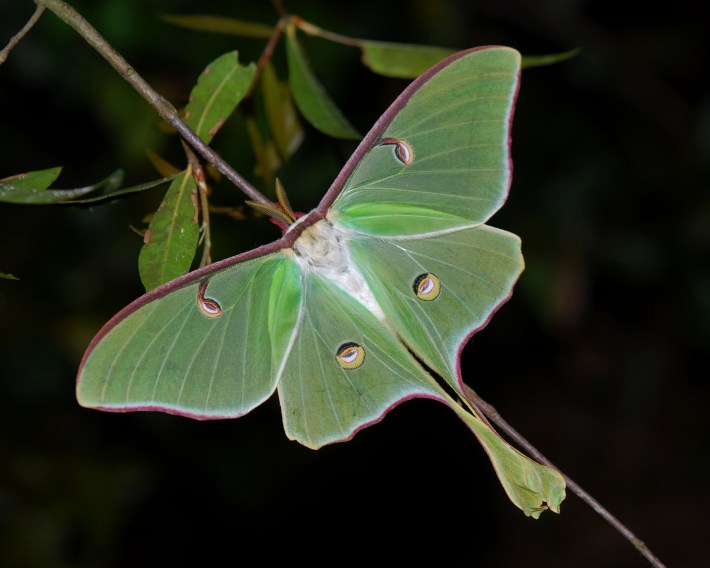
Himmelman, the author of Discovering Moths, also fell into mothing after seeing a conventionally hot moth: a rosy maple that alighted by his Connecticut porchlight. "I was blown away by the yellow and pink, sherbet-y colors," Himmelman wrote in an email. He was so struck by the moth that he went to the library and flipped through a book of insects to identify the species. "It was then, leafing through books on moths, that I saw what’s out there and I wanted to see more." Discovering Moths is, among other things, a compendium of the moths you can see in Connecticut, which is quite a lot of moths. You can see the volcanic colors of the cecropia, the largest native moth in North America, the molten red fur of its body and wings gray like cooled lava. You can see the trippy, scalloped pattern of a fat blinded sphinx. You can see fleets of pale beauties, whose sculptural wings are white-green like lichen. I found myself achingly jealous of the Nutmeg State's biodiversity.
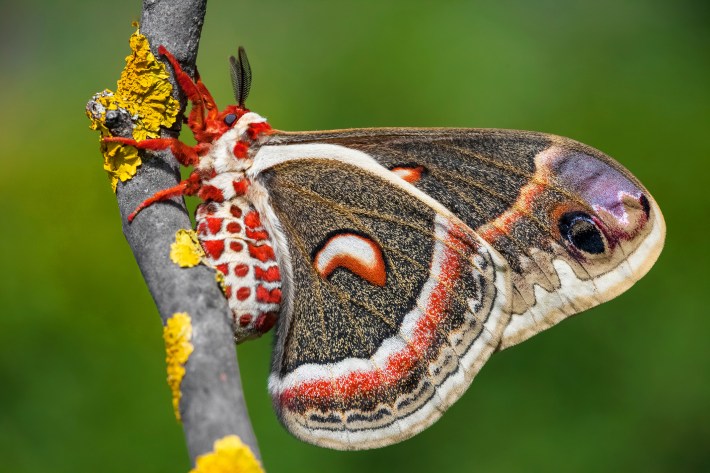
Himmelman began mothing casually by checking the light outside his house. Then he upgraded to hanging a sheet outside and running a UV light, which draws moths and other insects, along with a second light to observe the moths once they settle on the sheet. If he wants better pictures of the moths in daylight, he'll scoop them into small clear cassette tapes and put them in the fridge overnight. "That cools them down so they stop flapping around and are docile the next morning," he said.
Like some of our greatest books, Discovering Moths is a story about a person's descent into obsession. Himmelman finds himself writing past 2 a.m., the conclusion of a night of mothing. He writes about building his own moth traps (cutting the wires off a bug zapper) and concocting his own moth bait (fermenting a vat of brown sugar, stale beer, orange soda, mushy bananas, maple syrup, and a splash of peach schnapps). He goes to a veritable Lepidopalooza—a weeklong moth survey in the Great Smoky Mountains where an old-timer tells him about "tree-whipping," the practice of thwacking trees with a baseball bat to startle camouflaged moths, then scooping up the fliers. As I read, I gasped at the extents mothers would go for their craft. And I wondered if it would be against NYC Parks rules to smear fermented moth bait on the maple trees in Prospect Park.
I was getting ahead of myself. I hadn't even gone mothing yet. But by the time I'd finished reading Discovering Moths on the train to Hudson, occasionally stopping to look out the window and imagine the many moths that lurked in the distant woods, I had started to register the word "mother" as "someone who moths" as opposed to the other, more common definition. I felt like I was already in the club.
In Ghent, N.Y., Hawthorne Valley is home to a dairy, poultry, and vegetable farm, a Waldorf school, a charming grocery store, and the nonprofit Hawthorne Valley Farmscape Ecology Program, which conducts research and outreach into the culture, agriculture, and ecology of Columbia County. I'd cold-emailed the program several months earlier asking for mothing advice, and Conrad Vispo, a biologist who helps run the program, responded to my email. He recommended a few books, including Discovering Moths, and kindly invited me to come up and moth on the farm. I arrived an hour before sunset, and I helped Shira Linsk, an intern at the program, stake a white tent shaped like a plus sign designed for bug collecting into the grass beside a stream. She clipped a blacklight under the tent's ceiling, lugged out a cobalt blue block of a battery, and the set-up was complete. With nothing else to do but wait for nightfall, I wandered around burbling streams and tick-laden fields in the gauzy, golden light.
But I had seen streams and fields before, and, impatient, I quickly returned to the tent. Shira turned on the battery, the blacklight bulb smoldered an icy blue from the safety of its protective net, and we sat in substantial Adirondack chairs and waited. Small insects arrived almost immediately, speckling the tent like pepper ground onto an egg, but none were moths. We had placed the tent next to a stream, welcoming armadas of dainty caddisflies that were dwarfed by enormous, brutalist fishflies. Their numbers grew, embellished by beetles whose bulky bodies thudded like hail on the tent, and spiders that swooped in to spin webs and feast on this sudden buffet. All around us, fireflies blinked in twinkling strands. I had not come to see these insects, but I still marveled at them: watching a cockchafer beetle waggling its high-femme eyelashes and observing two coital stoneflies going at it.
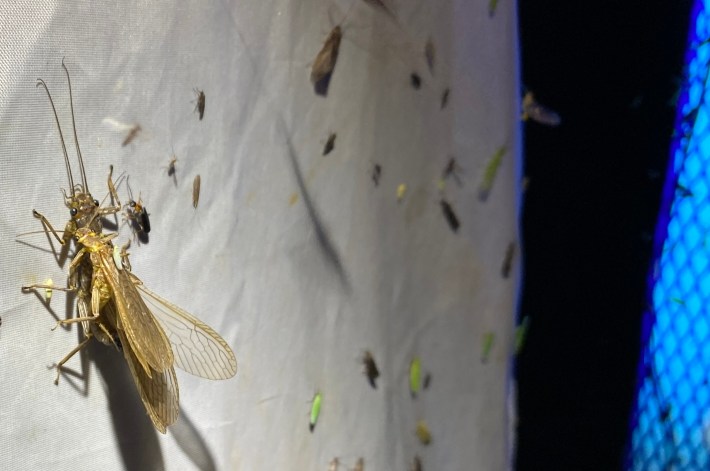
The moths were there, too—not on the sheet, but twirling in the tent's halo of light. Their papery fluttering wings and glowing pinprick eyes made them easy to pick out of the crowd. Scientists have long been unsure exactly why moths and other insects are drawn, sometimes inescapably, to artificial lights. Some posited that insects steered toward the brightest light in their vision, mistaking it for the sky or the moon, which they use to navigate. Others suggested it was not the light but the heat that lured them in. But many of these hypotheses assumed the insects were in some way attracted to light.
Earlier this year, a group of scientists might have solved the mystery. After filming a variety of insects including moths, dragonflies, and fruit flies with high-speed infrared cameras, the researchers noticed the insects were not flying toward the light, but flipping upside-down with their backs away from the beam. They were not drawn to a flame, but trapped in an orbit around it, attempting to keep their backside facing the brightest object in their sight. This behavior, also called "dorsal light response," helps featherweight insects know which way is up. For eons, the moon and stars were the only bright lights in the sky; streetlights did not figure into insect evolution. I watched the moths trapped in orbit around the tent but could not tell if they were on their backs, because I am, alas, not a high-speed infrared camera.
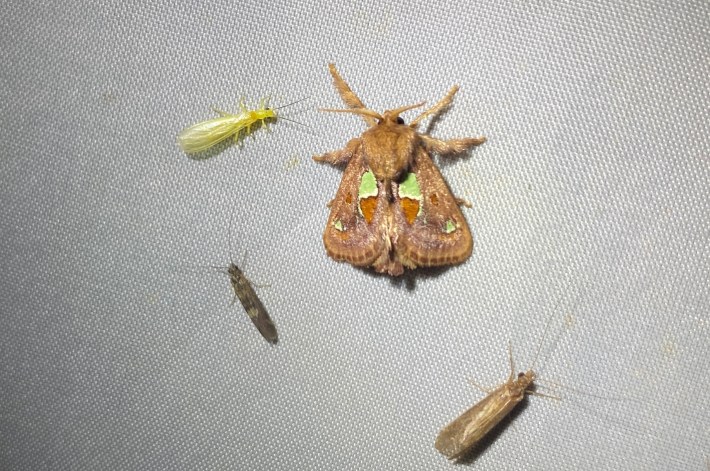
When the first moth landed, it felt like a miracle. We first saw it in orbit: a glitchy yellow streak. Its body was so chunky that it landed with an audible thud on the sheet, and unlike the many smaller crawling flies, it stuck. I stuck my head into the tent, my face blitzed with bugs, to see it up close. The moth was softly furred and khaki, with a scalloped border of tiny dots at the edge of its wings—an ursula wainscot, I would later learn. It looked so soft I had to resist the urge to pet it.
Like a rainstorm, that first drop trickled into a downpour of moths. The next one was perhaps my favorite of the whole night, with butter-yellow frontwings blotched with black scalene triangles and rosy pink underwings: a harnessed tiger moth. Before this night, I had decided not to look up any of the moths I might see in the Hudson Valley—besides the ones I already knew—so that my expectations would be low, and I might be surprised by any moth that alighted on the sheet. But to be graced with such a striking moth, so early on in the night? It was, for me, a 20-pigs moment.
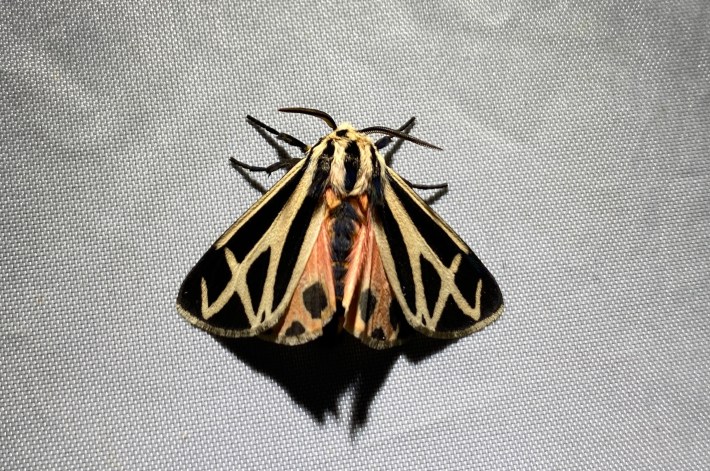
Other tiger moths soon joined the sheet, including an Isabella tiger moth—a species more famous as a baby, when it's called a woolly bear caterpillar—and the banded tussock moth, whose wings recall ink clouds on a silk painting. It took each of them a few tries to land, whirling in and out of the glow of the tent before thumping softly onto the sheet. At first, they appeared to be the only moths. But when I peered more closely at the smaller insects that clung, unmoving, to the sheet, I saw many of these were moths, too. A white-spotted leafroller, dappled like a fawn and less than an inch long. A tiny yet unabashedly rococo pink-shaded fern moth, its furred legs splatted on the sheet. A spiny oak slug—named not for its adult self, which is squat and furred and perfectly cute, but its juvenile self, which looks like a gummy candy that could kill you. There were so many moths! I found myself exclaiming "wow" again and again like a broken squeaky toy.
But for every new moth, we saw dozens, if not hundreds, of other insects, many of which were extremely tiny and which flew, as with a death wish, into my nostrils, my ears, and directly into my eyeballs. There is nothing in the world like feeling a small, moving thing plummet onto your cornea, blinking, only to realize the thing has stopped moving but remains there, glued to the slick of your eye. I worried that some of the flies might actually make it into my ear canal, which I understand is a comfortingly warm space—The Wing, for bugs. And although I have recently challenged myself to appreciate insects and even unlearn some of those fears, I had never been so smothered by bugs, and the more I sweated, the more they stuck to to the grime of my face and body. I occasionally had to walk away from the tent and shake myself vigorously like a chihuahua in order to feel clean. But I wanted to see the moths. So I powered through, taking deep breaths and sticking my face under the tent to appreciate the intricate patterns, the feathery plumes, and those adorable big, black eyes.
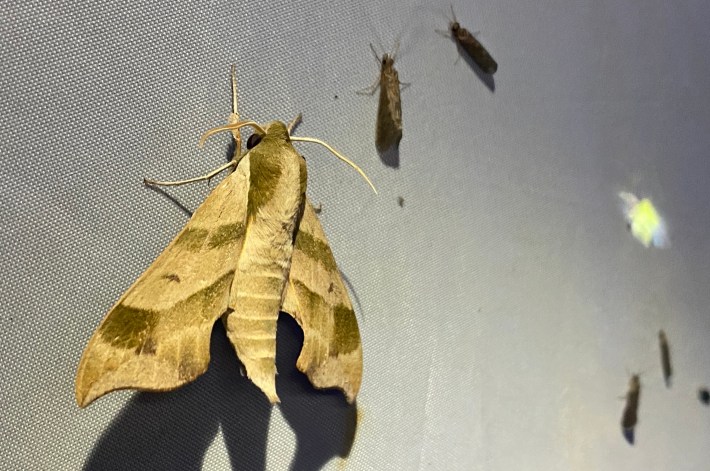
One moth, however, was so hefty that I could see it clearly from outside the tent: a sphinx moth. I'd seen sphinx moths, also called hawk moths, before in Joshua Tree. They whirred around a cluster of flowering shrubs, unfurling their proboscis to sip nectar from the blooms. Like many people, I first mistook them for hummingbirds before realizing they were not birds, but insects. The Virginia creeper sphinx that landed on our tent could have easily passed for a small bird. Her abdomen was simply enormous. She felt more like a puppy than a bug. Although the tiger moths came and went, rocketing off the tent and reappearing on another end, the sphinx moth had seemingly settled in for the night, not budging from her spot even when Shira or I tripped over one of the tent's stakes and sent a flurry of bugs back into the night sky.
I orbited the tent for more than three hours. Sometimes I would sit beside a particularly beautiful moth and admire them. Sometimes I would circle the light and take in the spineless splendor of what felt like a rave for bugs, with so many fliers looping around the blue light and several moths visibly vibrating their antennae. Although most of the moths were shades of brown, yellow, green, and white, the final moth of the night resembled a piece of jewelry: silver wings, coral-colored head, and a turquoise body. It was a Virginia ctenucha, a moth I later learned flies primarily during the day but is still drawn to light at night. Perhaps I'd seen it before and mistaken it for a butterfly.
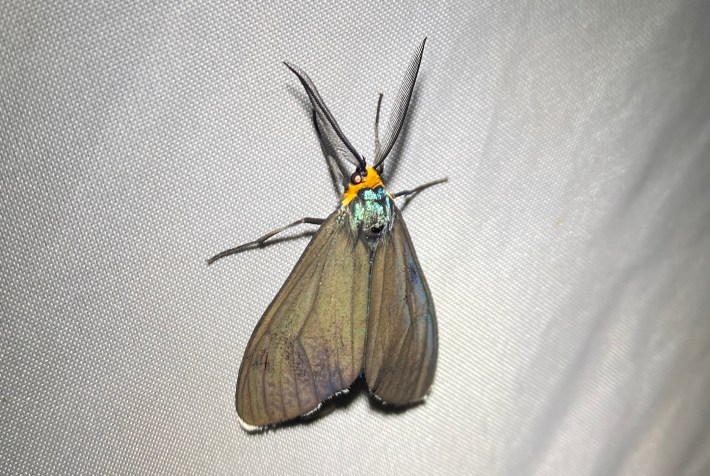
By midnight, the bugs were still flocking to the tent. I could have stayed out for longer, but I felt unexpectedly winded after three-plus hours of constant six-legged stimulation. So, for the last time, I ducked into the melee happening under the tent, unclipped the bulb, and turned off the lights.
It's somewhat amusing that the more one moths, the more one becomes like a moth. In Discovering Moths, John Himmelman writes about how he, like many other wildlife enthusiasts, abhors light pollution, which can disorient and even doom some animals. "But if there is a light on the side of the road or the side of a building, I'm drawn to it like the moths that have no choice," he writes. Since my first outing in the Hawthorne Valley, I've found myself hovering under streetlights and lingering by white walls, wondering what I might see. For the moth-curious, this might be the most accessible entry into the hobby (a mercury vapor light is great gear, but far from necessary to see moths). Peek under porchlights or other artificial illumination and see who else has shown up.
In Himmelman's eyes, one of the advantages mothing has over birding is that "you’re almost always going to see something that you’ve never seen in your life." In Connecticut, he explained, there are about 450 species of birds, compared to 2,600 moths. In this way, mothing is a way of appreciating the overlooked abundance around you. In my first day as a mother, I had already been astounded by the spectrum of body shapes, colors, and stupidly fluffy legs of everyone who visited my sheet. And as someone who is not and will probably never be a morning person—a time of day that is best for birding, or so I hear—I felt very glad to have found a pastime better-suited for creatures like me, who are inclined toward depraved and erratic sleep schedules and who never want a day to end.
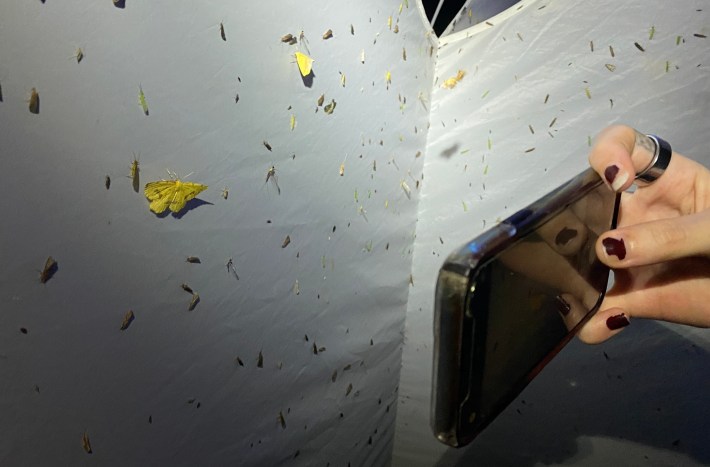
For Himmelman, part of the joy of mothing is that the activity is best when shared among buddies. He and his friends will set up a sheet and a light anywhere: his house, his buddy's house, a local park. "We sit, talk about everything under the moon, have a couple beers, and periodically wander over to the sheet to see who’s shown up," he said. One of my favorite moments in Discovering Moths was an interview with a guy named Gary, who Himmelman met on an online forum devoted to butterflies and moths. Gary was a frequent poster in the forum and self-taught lepidopterist—even learning how to inflate a moth bladder during recreational moth genital dissection—who almost exclusively wore denim. Gary told Himmelman that all he wants out of life is "a warm summer night with a sheet, a mercury vapor light, a six-pack, some mosquito repellent, and my buddies Dave and Chris. Lots of stars. Some night birds. And every now and then a REALLY GOOD moth."
I thought about Gary's words on the train back to New York City, a ride I always dread because it means leaving sweeping forests and coursing rivers and returning to the hostile chrome purgatory of Moynihan Train Hall. I was about to turn 30 and had spent the months leading up to my birthday casually freaking out about the meaning of my life. What did I want to do with my time? Where did I want to live, and where did I want to die? How much of the world could I ever see? I had circled around these big questions endlessly with my friends, my partner, and my beleaguered therapist, and always had difficulty imagining or even looking forward to my future. But Gary's words offered me the first answer that felt real: a night out under the stars with my buddies, and, if we were lucky, every now and then a REALLY GOOD moth. How could I possibly ask for more?
